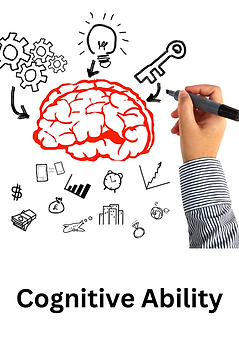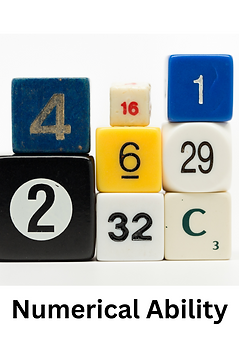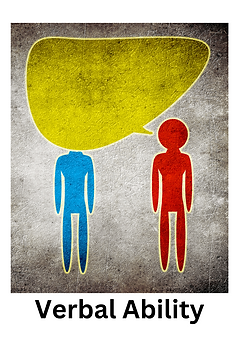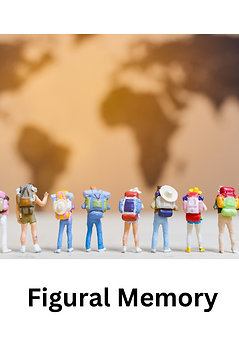Steps - How We Conduct
01
It is computerized test, which approximately takes 2.5 to 3 hrs.
02
It is designed for the students from 10th Grade, 12th Grade to undergraduate.
03
Students / Schools / Organizations have to register for the test and then appear for the test on schedule date, time and location.
04
Each student has to take test individually without any outside help except the trained test administrator.
05
Students who are looking forward to take the test, don't need any special training or preparation.


Cognitive Ability
The mental capacity or ability of a person to process, understand, and use knowledge is called cognitive ability. It includes a lot of different brain functions, like memory, attention, language, decision-making, reasoning, and problem-solving.
They have a big impact on how well you do in school, at work, and in your general quality of life.

Social Ability
People's social ability is how well they can get along with others in different types of social settings. Some of these skills are active listening, empathy, communication, working together, and knowing how to deal with social rules and expectations. Understanding people through their thoughts, facial expressions, gestures, and postures is an important part of social ability.
.png)
Reasoning Ability
Reasoning ability is the ability to think clearly, draw conclusions, make assumptions, and solve problems based on the information you have. It is the process of looking at information with a critical eye, finding patterns or connections, and using those to help you make choices or judgments.
.png)
Numerical Ability
Numerical ability, which is also called numerical aptitude or quantitative thinking, is the skill and knowledge of how to understand and work with numbers. It means being able to do math operations, figure out numerical problems, and correctly understand numerical facts.
Being good with numbers is important in many areas, such as business, science, engineering, schooling, and daily life.
.png)
Verbal Ability
This ability helps to understand the meaning and underlying concepts of words through language so as to learn and gather more and more information. It includes reading, writing, listening, and speaking aspects of language which can help you to gain mastery over particular language and get success at school level also.
.png)
Spatial Ability
Spatial ability is the mental ability to understand and change how shapes and things fit together in space. We need this ability in day-to-day life to make a judgment about special measurements with respect to length, width, depth, distance, speed, etc.
.png)
Numerical Memory
Being able to remember and quickly retrieve numerical knowledge is known as numerical memory. This includes remembering lists of numbers, facts about numbers, mathematical methods, and other kinds of quantitative data.
Numerical memory helps people quickly store and retrieve knowledge that they need to solve numerical problems. This includes remembering the rules, steps, and methods of math that are needed to solve problems.
.png)
Figural Memory
Figural memory, which is also called visual memory, is the skill of remembering things you see, like shapes, patterns, pictures, and how things fit together in space. It includes putting things, symbols, or scenes in your mind and then getting them back.
This ability is essential in all academics as well as in the day to life scenarios.
.png)
Knowledge Orientation
The way a person thinks about getting, organizing, and using information is called their knowledge orientation. It includes how a person understands and uses information, as well as their thoughts and actions when it comes to learning and getting new information. Some important parts of information orientation are these:
Learning Style, Curiosity and Inquiry, Openness to Experience, Knowledge Seeking Behavior, Critical Thinking and Analysis, Application of Knowledge, Lifelong Learning.
Practical Orientation
Practical orientation refers to an individual's tendency to approach tasks, problems, and situations with a focus on practicality, effectiveness, and real-world application. It involves prioritizing concrete actions and solutions over theoretical or abstract considerations. Here are some key characteristics and aspects of practical orientation:
Concentrate on Finding Solutions, Focus on Efficiency, Hands-On Method, Problem-handling Skills, Resourcefulness, Results-Oriented.
Social Orientation
People's social orientation is how they naturally connect with others, how they feel about relationships, and how they act in groups. It includes how a person sees, views, and interacts with other people in their social environment. Here are some of the most important traits and features of social orientation:
Ties with other people, Empathy and care, Communication Skills, Group Dynamics, Collaborating and Working Together, Community Engagement, Conflict Resolution, Social Awareness.
Artistic Orientation
When someone is artistically oriented, they like and are involved with the arts, such as visual arts, performance arts, literature, music, and other creative activities. It includes a deep respect for artistic expression, creativity, and new ideas in the arts. In general, having an artistic orientation means that you value creativity, aesthetic expression, and artistic discovery very highly.
Here are some of the most important traits and features of artistic orientation:
Creativity and Imagination, Respect of Aesthetics, Expressiveness, Exploration and Experimentation, Culture and Historical Awareness.
Power Orientation
People's thoughts, views, and actions about power and authority in social, organizational, or interpersonal settings are called their "power orientation." It includes how someone sees power, how they seek it, how they use it, and how they react to it. Here are some of the most important traits and features of power orientation:
Want to Have Control, Comfort with Hierarchies, Assertiveness and Dominance, Strategic Thinking, Demanding or manipulating others, Conflict Management, Taking risks, Moral and ethical concerns, Social Influence.
Faith Orientation
"Faith orientation" refers to an individual's or group's alignment, beliefs, and practices concerning faith, spirituality, and religion. Understanding a person's or group's faith orientation provides insight into their worldview, values, and motivations, and it plays a significant role in shaping personal and collective identity. This concept encompasses several dimensions:
Belief Systems, Religious Practices, Cultural and Community Aspects, Personal Spiritual Experience, Moral and Ethical Frameworks, Interfaith Perspectives.
Reports
Students receive a detailed report with percentile ranks and grades for each of the eight abilities and five orientations measured.
This report helps identify suitable educational streams and provides valuable insights for academic and career decision-making. Gain clarity on strengths and areas for development with this comprehensive assessment report.


